Distinguishing authentic orange carnival glass from reproductions is crucial for collectors. This article cuts through the complexity, focusing on key identification markers and value attributes of these iridescent antiques. Discover the fascinating world of orange carnival glass, learn how to verify authenticity, and gauge the value of your collectible pieces effectively.
Key Takeaways
Orange carnival glass, originating in the early 20th century, is prized for its iridescent sheen resembling luxury glassware and features unique patterns such as ‘Grape and Cable’ and ‘Peacock at the Fountain’ which enhance its collectibility.
Authenticating orange carnival glass requires inspection for manufacturer’s marks, signs of wear, and pattern details, with the value greatly influenced by the piece’s rarity, demand, condition, and historical production period.
Collectors can find orange carnival glass through various channels such as antique stores, estate sales, online marketplaces, and collector shows, and must be knowledgeable about their rights regarding cancellations, returns, and opting out of communications.
The Lustrous History of Orange Carnival Glass
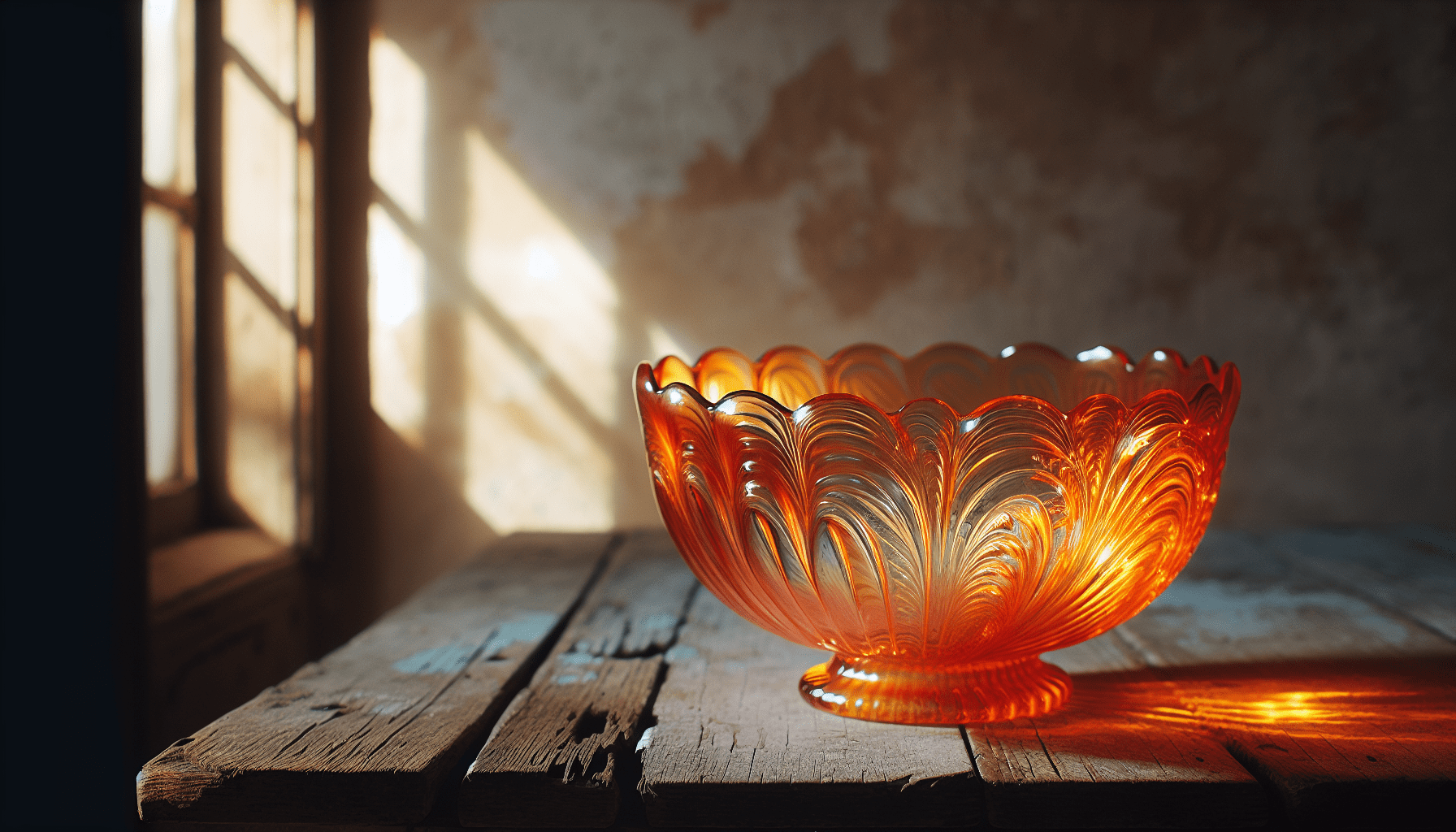
Commencing around 1908, the vibrant and gleaming carnival glass made its entrance as a budget-friendly option to high-end iridescent glassware, such as that produced by Tiffany. This economical alternative garnered affectionate recognition as ‘poor man’s Tiffany’. The innovative Fenton Art Glass Company, which came into being in 1905, spearheaded the manufacturing of this enchanting type of glass. Their goal was to recreate the opulent aura exuded by art nouveau icons including Tiffany and Steuben.
Captivating attention with its lustrous orange hue that sparkled even under subdued lighting conditions, orange carnival glass quickly gained popularity among consumers during times when electric illumination was considered an extravagance.
The Birth of Carnival Glass
Introduced in 1908 as ‘Iridill’ by the Fenton Art Glass Company, carnival glass became known for its iridescent sheen that mimicked high-end luxury glassware. The magical finish was created through the application of metallic salts to hot glass. This combination of a luxurious appearance and affordability made it a favored option among households aspiring to own elegant-looking glass without paying premium prices associated with elite manufacturers such as Tiffany.
The Orange Boom
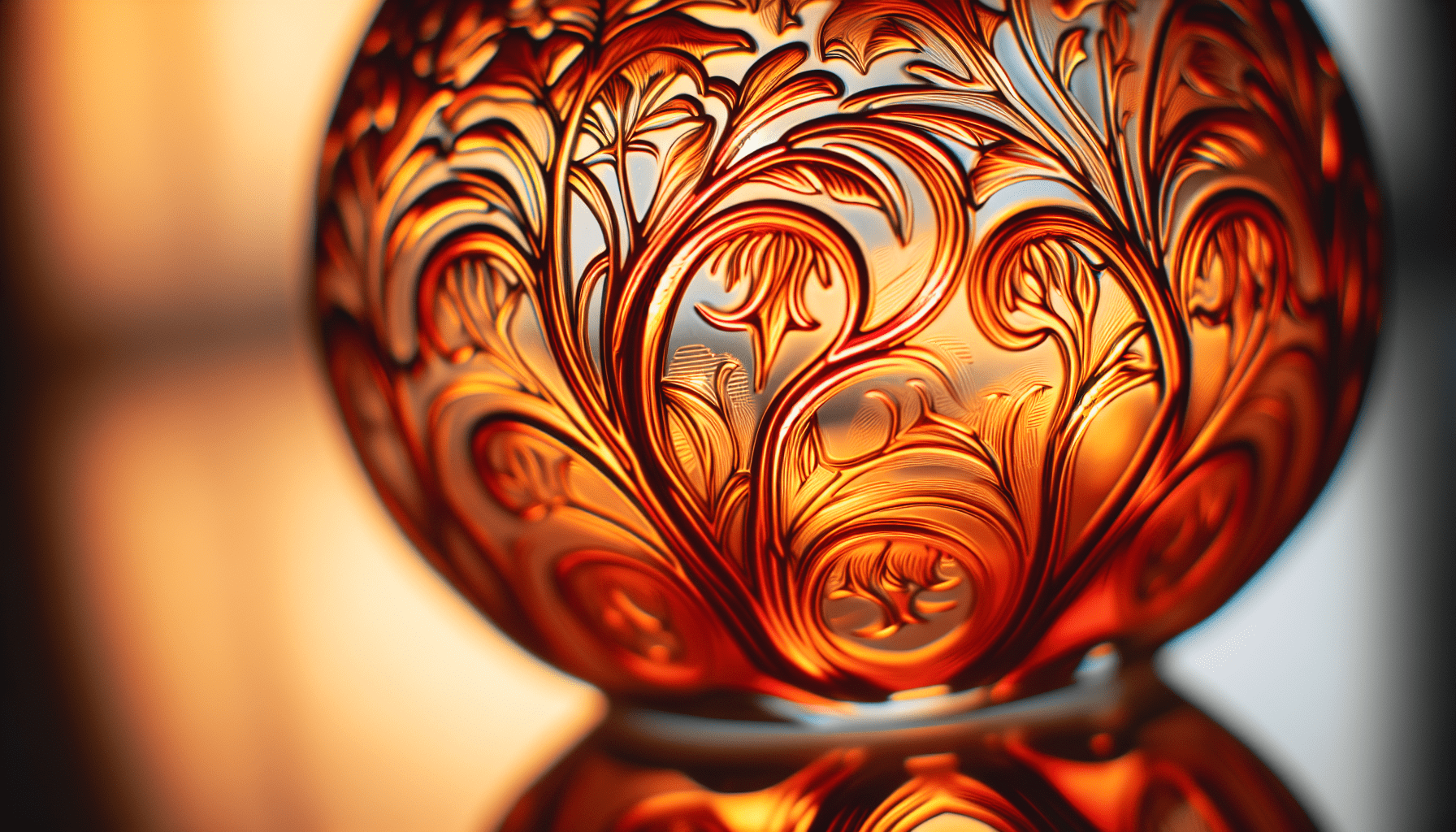
The fiery, warm tones of orange carnival glass have made it a particularly sought-after variation. Northwood’s ‘Grape and Cable’ pattern stands out with its intricate design featuring grape clusters and intertwined cables. In orange, this pattern is especially coveted. Imperial Glass Company’s ‘Hobstar and Arches’, which boasts a starburst motif framed by arches, becomes an emblem of authenticity regarding the piece’s age and provenance when presented in the orange shade.
Northwood’s ‘Peacock at the Fountain’ pattern also garners significant admiration when encountered in orange. It depicts an elaborate peacock adjacent to a fountain, captivating collectors with its detail. What amplifies their appeal is their appeal. Is that each genuine item was meticulously hand-shaped during production—adding another layer to these treasured artifacts’ charm.
Marigold vs. Orange: A Colorful Debate
In the realm of carnival glass, a particularly captivating debate revolves around determining whether a piece is true orange or marigold carnival glass. Marigold stands out as the most widely recognized hue in this type of glass, characterized by its vivid display of orange tones intermingled with yellow and gold hues, often accentuated by an iridescent sheen reminiscent of oil on water. For accurate identification of the base color in carnival glass pieces, one must examine sections not coated with mineral salts—usually found at the bottom part under appropriate lighting conditions—a process that might pose difficulties for those new to collecting.
Specific variants within marigold-colored examples exist. Notably ones set upon bases described as ‘moonstone’ or ‘milk glass.’’ These particular versions garner greater interest compared to standard marigold items because they exhibit a distinctive play on light when illuminated.
Identifying Authentic Orange Carnival Pieces
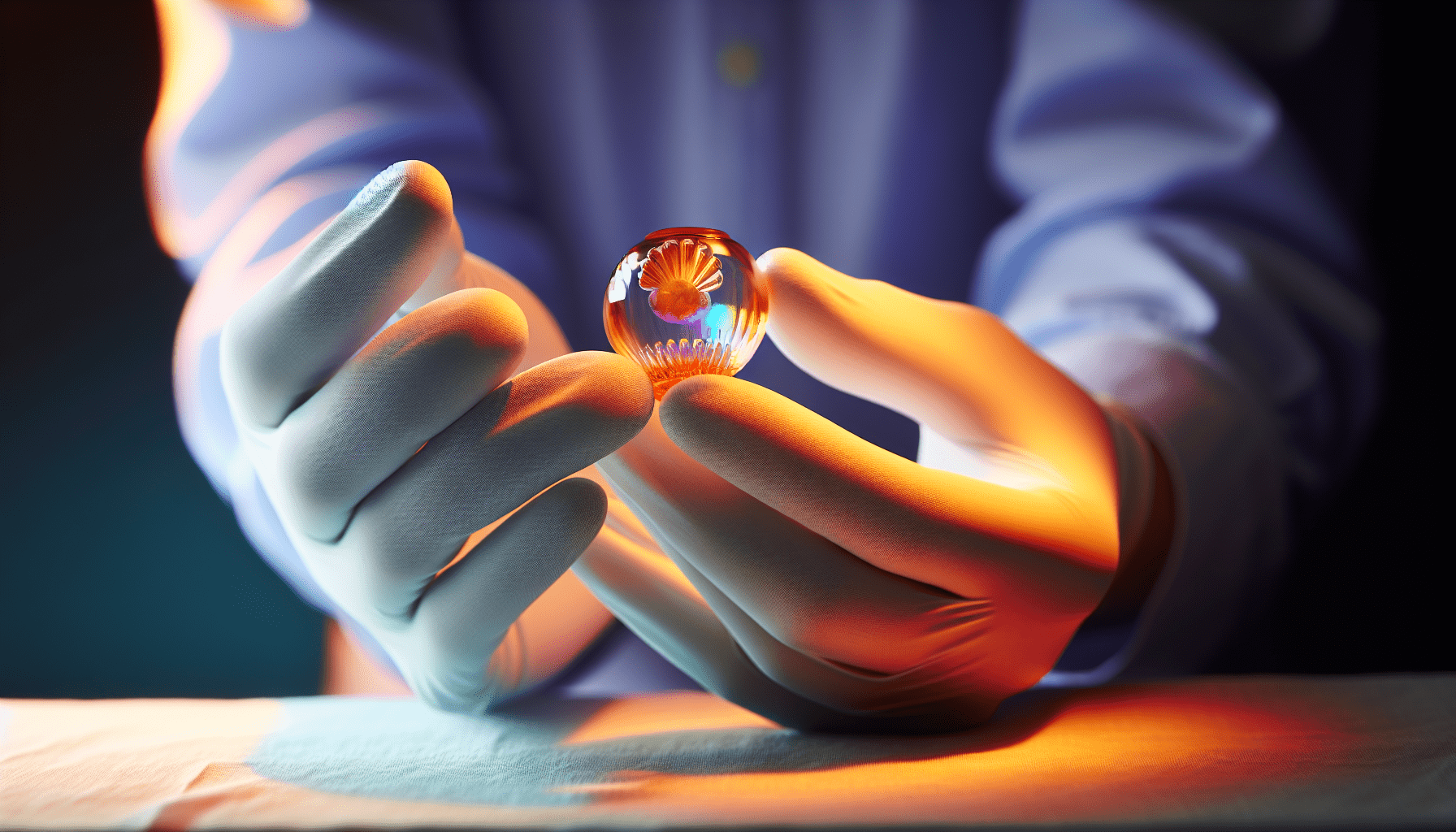
The art of collecting involves the crucial skill of distinguishing authentic vintage carnival glass from contemporary reproductions. True orange carnival glass exhibits a unique iridescence that is produced by applying metallic salts during its creation. Original vintage items tend to be heavier than their modern counterparts, reflecting the use of a heavier glass formula historically used. Experienced collectors can spot imitations by noting specific mold marks absent on genuine early 20th-century pieces.
An acute awareness of variations in orange color hues aids in identifying true carnival glass as opposed to recent replicas or dissimilar kinds of glassware. Indicators such as wear on the base or straw marks are hallmarks suggestive of antiquity and may confirm the authenticity of a piece as legitimate antique carnival glass.
Markings and Signatures
Carnival glass pieces that possess a manufacturer’s mark are more readily validated as genuine. While not every piece carries such a mark, those adorned with identifiers like Northwood’s encircled ‘N’ or Fenton’s circled ‘F’—which post-1980 includes an additional number representing the production decade—are reliably recognized as authentic. These marks may be subtle and necessitate close examination in well-lit conditions to ensure proper identification.
Equally significant is the recognition of counterfeit marks that attempt to replicate those of original manufacturers, adding complexity to the authentication process for carnival glass collectors and enthusiasts.
Condition Matters
When evaluating a piece of carnival glass, its condition is a critical factor. Various types of damage, such as:
chips
cracks
scratches
water stains
This can lead to substantial reductions in the item’s value. Chips can vary from being minor surface blemishes to more significant gouges that are easily noticeable and thus impact the value much more heavily.
Carnival glass may feature hairline cracks, which are thin and do not compromise its overall stability, or it may have internal fractures which both weaken the structure significantly and stand out visibly.
Even slight scratches on carnival glass can present an uneven texture or feel sharp when touched. Similarly, water marks tend to be stubborn imperfections that also devalue these collectibles considerably.
Patterns That Shine
The unique designs present on orange carnival glass significantly contribute to its authenticity and appeal among collectors, beyond the condition and identifying marks of the maker. Celebrated patterns such as ‘Orange Tree’ are highly regarded for their intricate depiction of robust trees. Other esteemed patterns including ‘Peacock at the Fountain’ and ‘Grape and Cable’ indicate creation by reputable manufacturers, making them coveted items in collections.
Patterns serve as a crucial factor when assessing the value of pieces due to their complexity, scarcity, and association with renowned producers.
How to Value Your Orange Carnival Glass
Recognizing a genuine piece of orange carnival glass is just the beginning. Determining its worth comes next. The value is determined by various factors, such as the specific pattern, which company made it, and when it was produced. Highly coveted patterns like Hobstars and Arches from Imperial Glass Company can affect how much these items sell for.
Orange carnival glass crafted during its golden age – specifically between 1907 and the 1930s – tends to be regarded with greater esteem among collectors.
Rarity and Demand
In the world of orange carnival glass collectibles, the value of each piece is considerably impacted by its scarcity and popularity among collectors. The more unusual an item is and the better its condition, the higher its potential value will be. When certain patterns or designs were produced in limited quantities, those pieces became harder for enthusiasts to locate and thus may carry a heftier price tag. Carnival glass items that are not as commonly seen or possess distinctive features tend to command premium prices.
Valuable items such as signed:
vases
pitchers
bowls
platters
They command higher prices when they are part of a complete set. For example, marigold decanter sets with matching cordials have realized high sales figures due to their completeness. Unique characteristics like ‘smoked’ over-fired glass could enhance an item’s desirability because it adds rarity—even though it might affect transparency or color—potentially increasing its market value.
Assessing Performance in Sales
Examining historical sales data and auction outcomes can offer valuable insights into the fluctuating values of collectibles. For example, a marigold Northwood’s Grape and Cable pattern punch bowl set recently commanded approximately $2,000 on eBay, showcasing robust market performance for scarce carnival glass items. This is Evidenced by the sale of a Dugan’s Farmyard pattern carnival glass bowl in impeccable condition that garnered upwards of $3,800 through an eBay auction.
The Impact of Condition
The market value of a piece is heavily influenced by its condition. Items in pristine condition are held in higher esteem, whereas prevalent problems such as chips, cracks, scratches, and discoloration can diminish an item’s market value. Similarly, carnival glass pieces that exhibit scratches or diminished iridescence from wear will likely see a reduction in their appraisal.
Even though damage may reduce the value of a piece, sought-after carnival glass items have the potential to fetch considerable sums. If there are parts missing from a set, this usually results in decreased value for the collective ensemble.
Where to Find Orange Carnival Glass for Sale
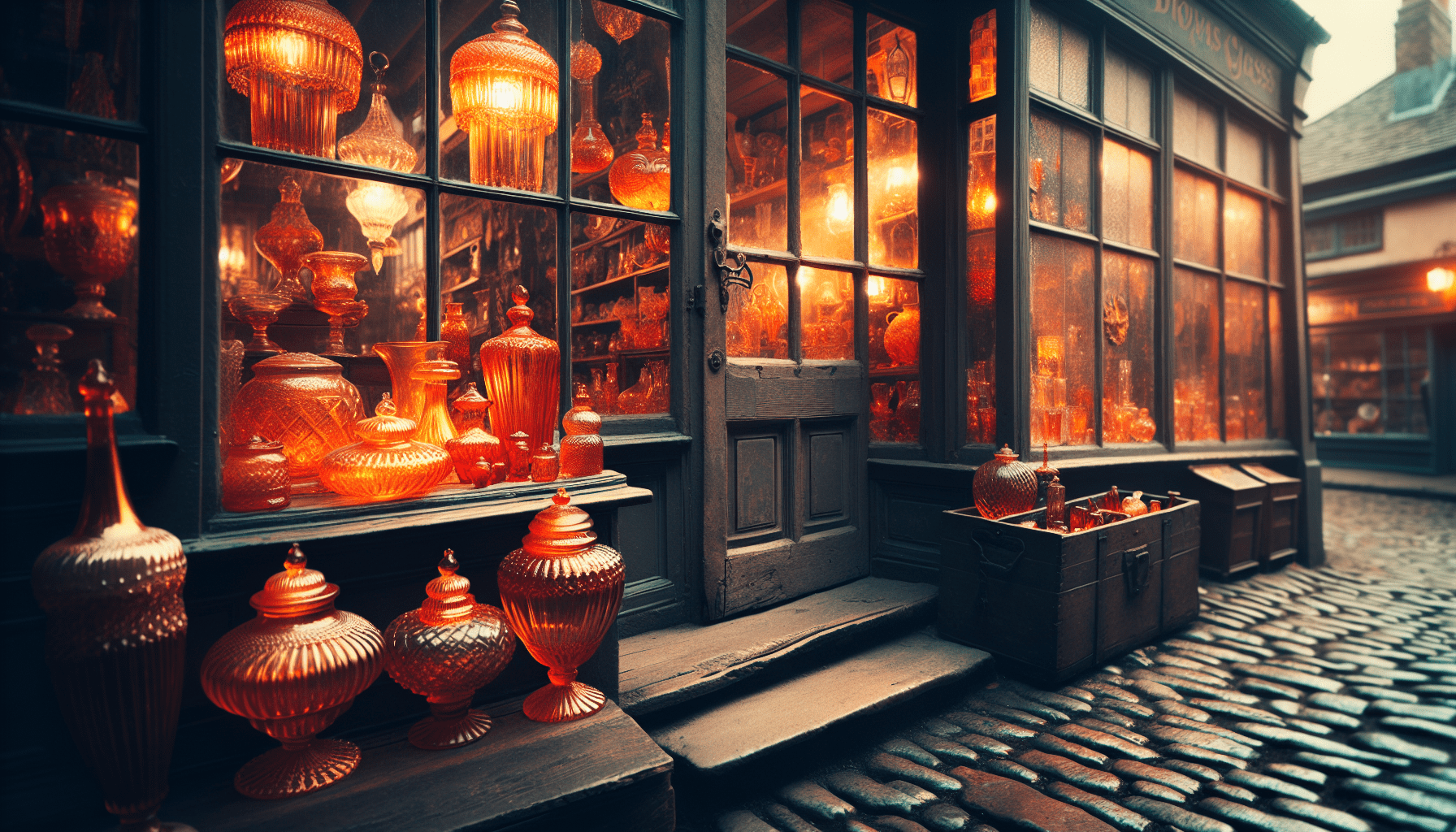
If you’re equipped with the understanding of how to recognize and appraise orange carnival glass, the subsequent inquiry is where one might acquire these radiant antiquities for purchase. Potential sources include:
Antique shops in your vicinity
Digital sales platforms
Sales from estates
Bidding at auctions
Shows dedicated to collectible glass items
Antique Stores and Estate Sales
Antique stores in the area feature a variety of orange carnival glass, offering an engaging experience for those looking to discover their ideal item. Estate sales present a prime opportunity to uncover distinctive and possibly scarce items often nestled within their listings.
Online Marketplaces
Online platforms like eBay and Etsy host a diverse collection of orange carnival glass products from multiple vendors, offering buyers an expansive and accessible range to choose from. Sites such as LiveAuctioneers present the chance to acquire orange carnival glass pieces or even complete sets through their online bidding system.
Auctions and Collector Shows
Collectors in search of premium orange carnival glass pieces might find specialized auctions and collector shows highly beneficial, since these venues often feature a varied selection of carnival glass items.
Enhancing Your Collection
Upon adding orange carnival glass to your collection, the next phase is to elevate its display or integrate these pieces into your home decor. Proper presentation not only heightens the charm of your orange glass assemblage, but also helps maintain its value.
Display Tips for Maximum Appeal
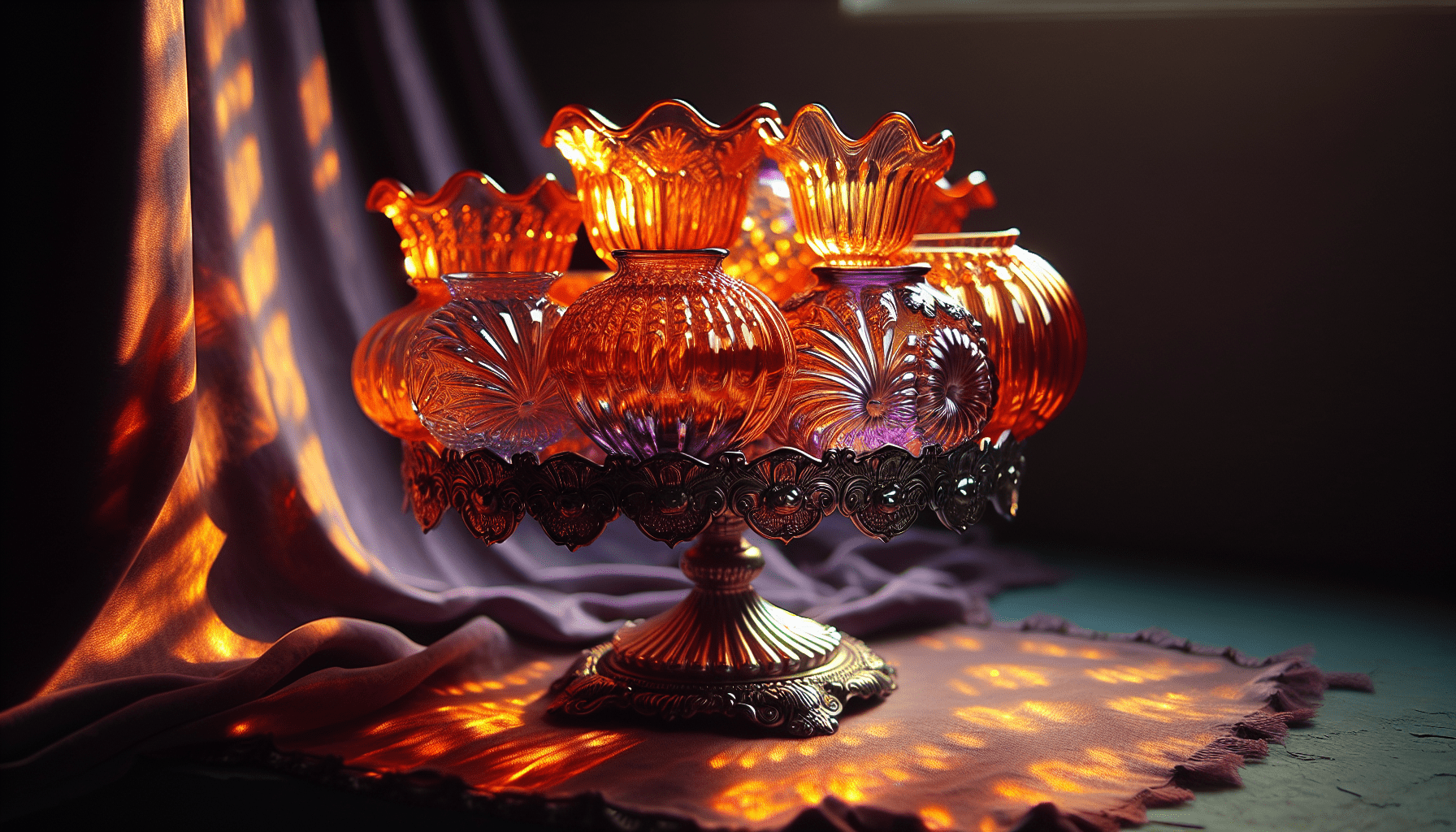
Position your orange carnival glass collection in locations where the interplay of natural sunlight and targeted man-made light, such as near a window or within an illuminated display case, can highlight its beauty. Utilize mirrors to amplify their glow and produce a captivating visual arrangement.
Create an engaging exhibition by assembling carnival glass items with diverse heights and contours. Arrange them against understated backdrops to emphasize the vibrant orange hues. Regularly change which pieces are on display within your collection, giving various items their moment in the spotlight over time.
Mixing Modern with Vintage
Integrating orange carnival glass into your home decor can provide a timeless charm that complements the modern interior. When you match an orange carnival glass piece with up-to-date tableware of harmonizing shades, it results in a unique and fashionable setting for your meals.
Consider these suggestions to infuse a hint of antiquity through carnival glass within contemporary spaces:
Positioning an ornate centerpiece fashioned from carnival glass on either your dining or coffee table.
Exhibiting an artistic bowl crafted from this distinctive material on shelving units or above the fireplace.
Embellishing fall-themed arrangements with touches of radiant orange carnival glass for added seasonal flair.
By embracing such concepts, you will be able to effectively weave vintage allure throughout your abode using pieces of striking orange-colored carnival glass.
Caring for Your Collection
To preserve the exquisite appearance and value of your orange carnival glass, it’s essential to take appropriate care measures. To clean without causing scratches that might spoil the iridescent surface, mix dishwashing liquid with room temperature water and gently wipe with a soft cloth.
Handle every piece of orange carnival glass delicately in order to minimize any risk of chipping or cracking, as such damage can lessen its aesthetic appeal as well as its monetary value.
Creating an Account and Preferences on Collectors’ Sites
Becoming a member of collectors’ websites offers the benefit of gaining entry to special listings and also allows you to engage with an active network of like-minded aficionados.
To begin your personalized collecting experience, these instructions will assist you in establishing an account and setting up preferences that align with your interests in collecting.
Setting Up Your Profile
When signing up for a collector’s site, it is standard to supply details like a username and bio, as well as identifying your collecting interests. Showcasing your passion for orange carnival glass within your profile can bolster your virtual identity and foster connections with individuals who have an affinity for the same type of collection.
Personalizing Search Filters
Optimizing your search filters to align with your preferences can streamline the process of locating particular pieces of orange carnival glass. Collector websites often feature advanced search options that let you specify factors like:
the depth of color
vintage or contemporary status
a spectrum in cost
state or quality
Utilizing these tailored parameters can assist in pinpointing exact items.
By establishing email alerts or application notifications for newly posted ads that fit your defined criteria, you can promptly respond when intriguing orange carnival glass listings arise, ensuring no chance slips by unnoticed.
Engaging with the Community
Platforms such as collectors’ forums and social media groups on collector-focused websites facilitate interaction among users, allow for the exchange of insights, and provide opportunities to display their collectible items. These platforms feature dedicated areas and conversational threads designed for particular kinds of collectibles where members can converse about relevant subjects and exhibit their associated pieces.
Incorporating individual anecdotes or tales about one’s journey in collecting into your profile can add a distinctive flair that might stimulate more involvement from the community.
Opting Out and Cancelling: Know Your Rights
It is crucial for you as a consumer to be well-versed in your rights when it comes to canceling orders, returning items, and opting out of marketing communications. You are legally entitled to cancel an order within a designated window, often before the processing or shipping stage. If you decide to cancel an order prior to its shipment, you should expect a prompt refund of the full amount.
When dealing with orange carnival glass purchases specifically, customers have the option of returning these items consistent with the return policy outlined by individual sellers. Should consumers choose not want Advertising material sent their way after making such purchases from sellers that offer orange carnival glass among other things, they can opt out. Once this preference is communicated, it’s imperative for sellers to comply immediately and stop any subsequent promotional information directed at that customer regarding those particular glass items or otherwise.
Summary
The world of orange carnival glass is as colorful and fascinating as the radiant sheen and complex patterns that define it, captivating collectors across the globe. Our exploration has provided us with a deep understanding of its lustrous history, the skill involved in discerning genuine artifacts, and the subtleties entailed in appraising their worth. We’ve delved into diverse methods to locate these prized items while also acquiring knowledge on how best to showcase and maintain our collections. The realm of orange carnival glass presents boundless opportunities for aficionados to discover and educate themselves. And revel in admiration.
Frequently Asked Questions
What is orange carnival glass called?
Collectors label the striking orange hue of carnival glass as “marigold,” a color that gained significant popularity for carnival glass during the early 1900s.
What are the rarest colors of carnival glass?
Collectors highly prize cherry red, black amethyst, and ice green as the most elusive and esteemed colors of carnival glass due to their rarity and value.
Does orange carnival glass glow?
Indeed, the golden orange hue of orange carnival glass is attributed to iron chloride present in the spray coating applied to transparent glass, which imparts a sparkling iridescence. This component is what gives the glass its distinctive glowing appearance.
How can you tell if carnival glass is vintage?
To determine whether carnival glass is of an older vintage, scrutinize its hue and design as well as any indications of wear or damage. Also, inspect for the maker’s stamp and watch out for a rust-like look that may result from metal oxide aging over time.
What factors affect the value of orange carnival glass?
The market value of orange carnival glass is shaped by various determinants, including the pattern design, the maker of the piece, the period during which it was produced, its scarcity and popularity among collectors, as well as its state. Each of these components is essential in assessing its financial significance.

